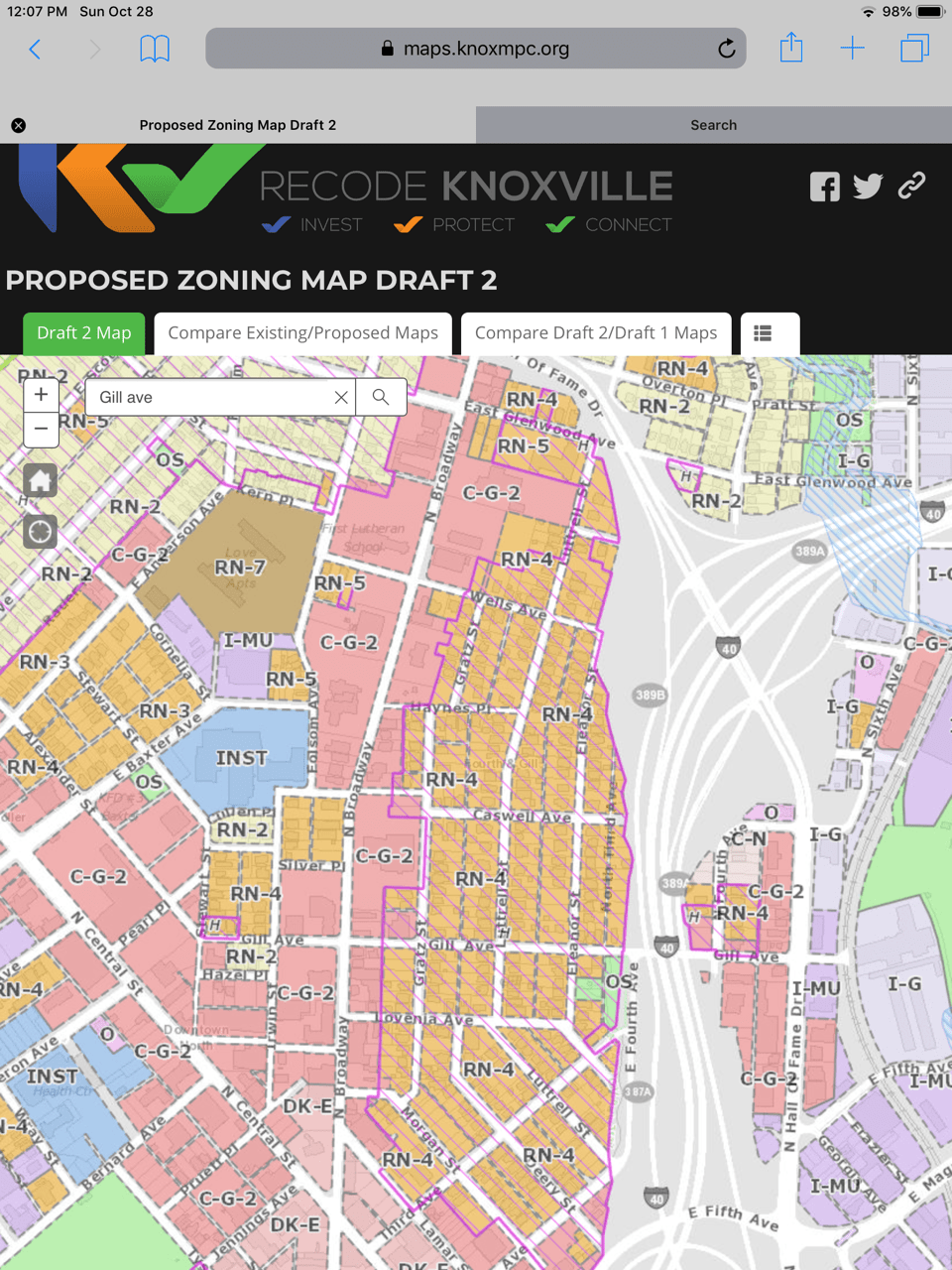Proposition: Knoxville needs more affordable housing.
Question: How do we get there?
Solution: Increase transit-based housing using the RN-4 multi-family zone. Plus ADUs.
Where: Anything within a quarter-mile of a bus route is fair game.
In the latest round of Recode updates – text draft 3 and zone map version 2, released in mid-October – MPC has mapped several neighborhoods and corridors within a quarter-mile of the KAT bus routes as RN-4, a multi-family zone allowing up to 20 units per acre.
Presumably most of those will be one- and two-family houses and midsize townhouses (with 1-8 units), and some larger multi-family buildings as special-use structures (up to 20 units per acre).
The map shows Recode swallowing up established single-family neighborhoods like 4th & Gill, Parkridge, along Magnolia Avenue, a few parcels in Fountain City, and in other areas of town.
Will developers and speculators take a wrecking ball to several historic houses to cram in a 20-unit mid-rise apartment? Isn’t one of Recodes stated objectives to “protect?”
MPC executive director Gerald Green explained to attendees at the Deane Hill Rec Center meeting on Oct. 24 that these RN-4 decisions reflect the NAACP’s racial fairness comments and those of Bring Back the Orange group, both of which favor adding more affordable housing.
But, if you raise the curtain a bit you can see the hidden hand of Mayor Rogero acting out her Plan ET density desires. Thus, current KAT placeholder-chief Belinda Brill submitted a 4-page memo to MPC outlying this transit housing scheme. A bus line route map shows a quarter-mile border of such potential housing sites:
“The most fundamental example of successful and efficient transit is density… the zoning code provides an opportunity to increase densities along major transit corridors, or in particular nodes along those corridors.”
Other potential RN-4 zone locations identified include Washington Pike at Whittle Springs and the Oakwood-Lincoln Park community. The KAT memo ends (at p. 4) praising ADUs as another such housing opportunity used by the author while in grad school.
Neighborhoods would do well not to take your eye off the Recode version of the moment. It’s a constantly moving target. Recall that the RN-4 zone was not used in the earlier draft. It was just a future placeholder zone, not yet employed. What’s next?
Other Meeting Comments. Representatives of West Hills (1,200 homes) stated concerns about including ADUs in every zone in Recode, which still has not adopted recommendations that they be allowed only on owner- occupied properties. A resident said: “I want to know that my investment in my home is safe.” Owner occupancy would be some “security to the homeowner.” Another comment was to “move slower” on these changes. You know, test the waters before we dive in head first. The MPC director suggested, “We can come back to the adopted code in a year and see what needs fixing.”
A spokesperson from another neighborhood said, “Why not make these ADUs a special use?” That way neighbors would get notice of changes.
But city codes chief Peter Ahrens assured there would not be many of these ADUs built because of cost. “It would be hard to get your money back (he suggested a $100k investment was needed) from rents at $750 per month.”
Plus, Ahrens said, we would not know who owns these properties once the original owner sold their house. “You can’t expect our guys go out an interrogate the occupants.” He seemed unimpressed with the notion that our existing complaint-driven-system would allow the neighbors to call rogue uses to their attention – yet that is the only way most code violations ever get enforced.
Another interesting exchange about why not look at all the tools for affordable housing before adopting the current approach in Recode, ended with Green stating that “affordable housing is not a planning issue.”
Huh? Then why are the planners including this stuff in our supposed attempt to clean-up our old tired code?
Why not pass a cleaned-up modern code, with lean text and good graphics, and then, at a later date, put some of these “iffy issues” on the table to seriously debate one at a time?
One gets the feeling we will not find all the Easter eggs nestled in this 200-page grass.

